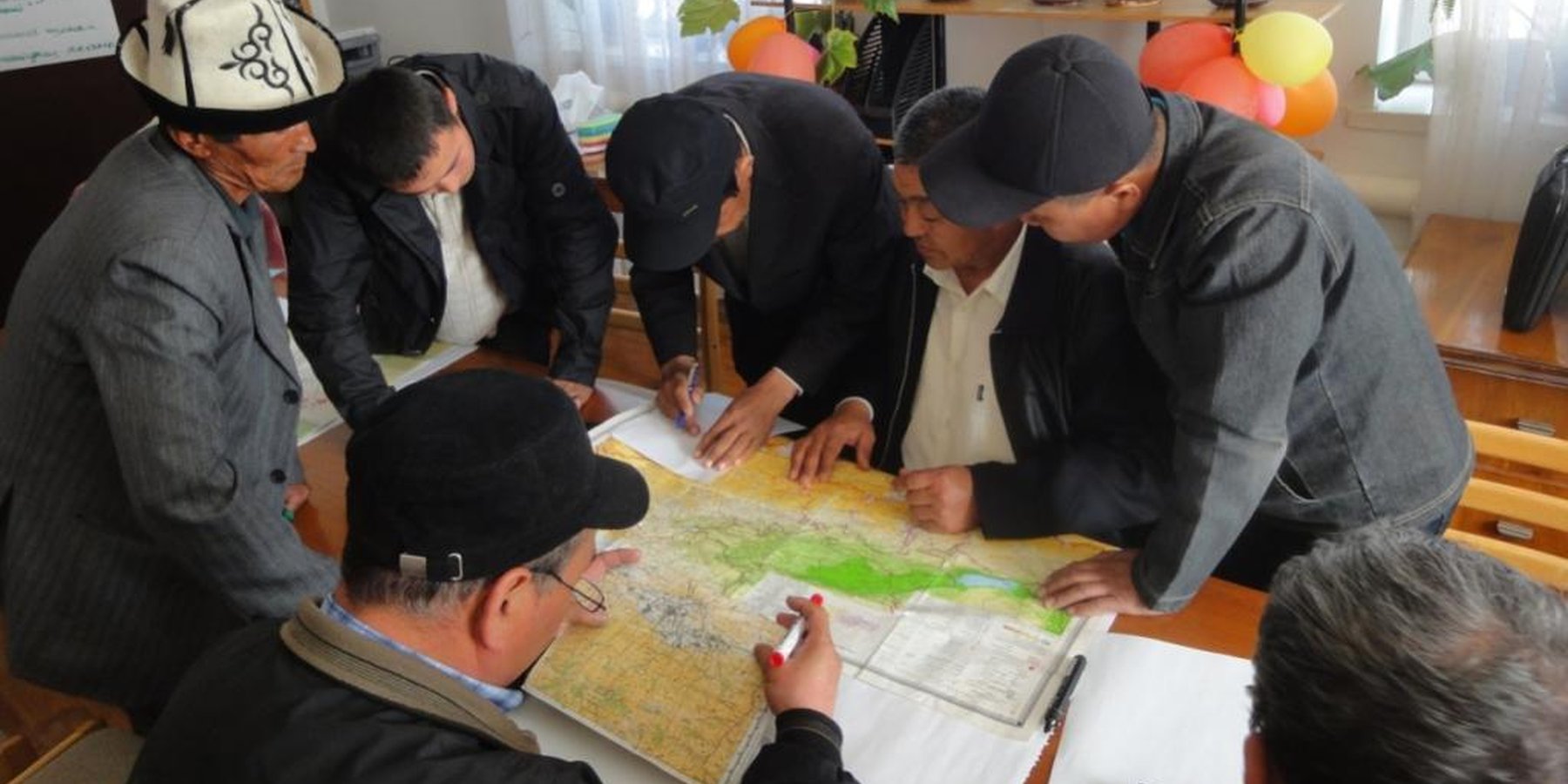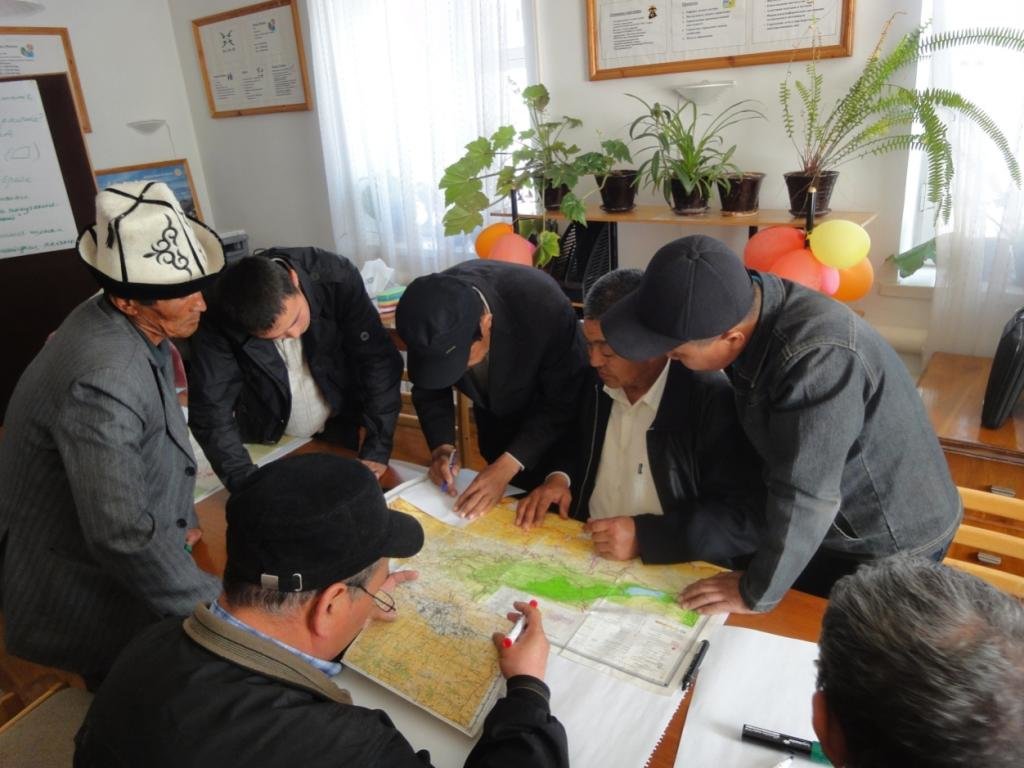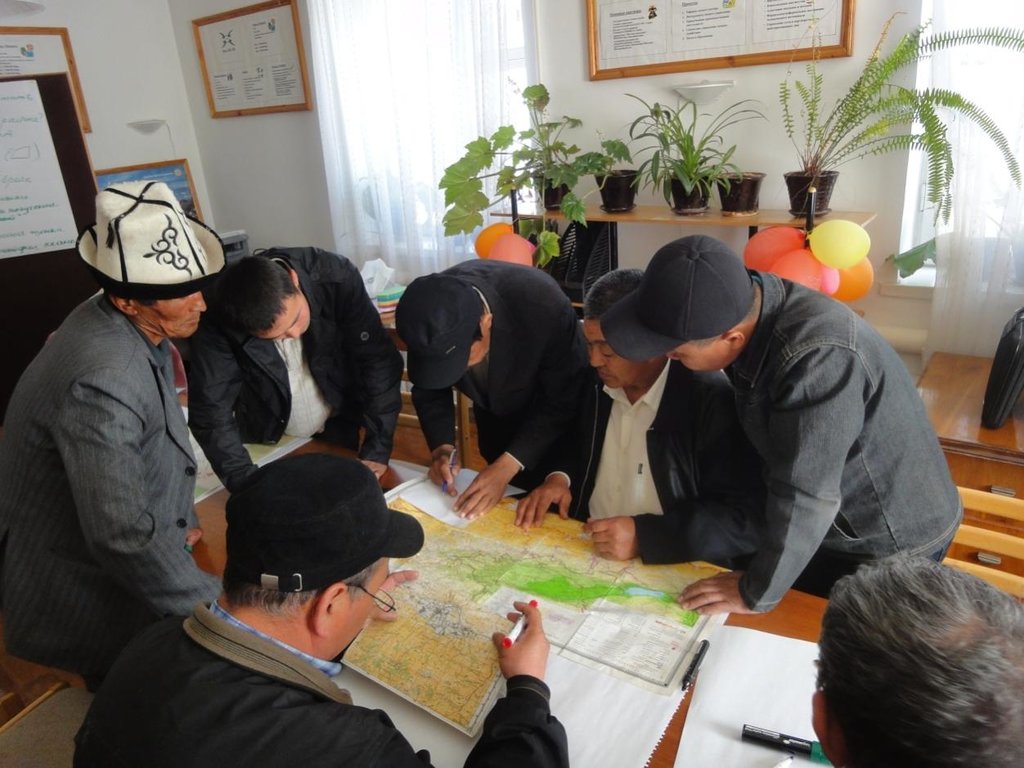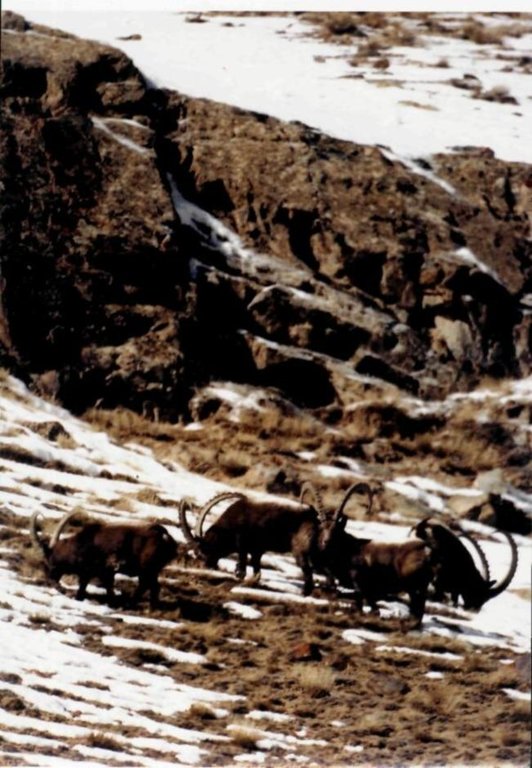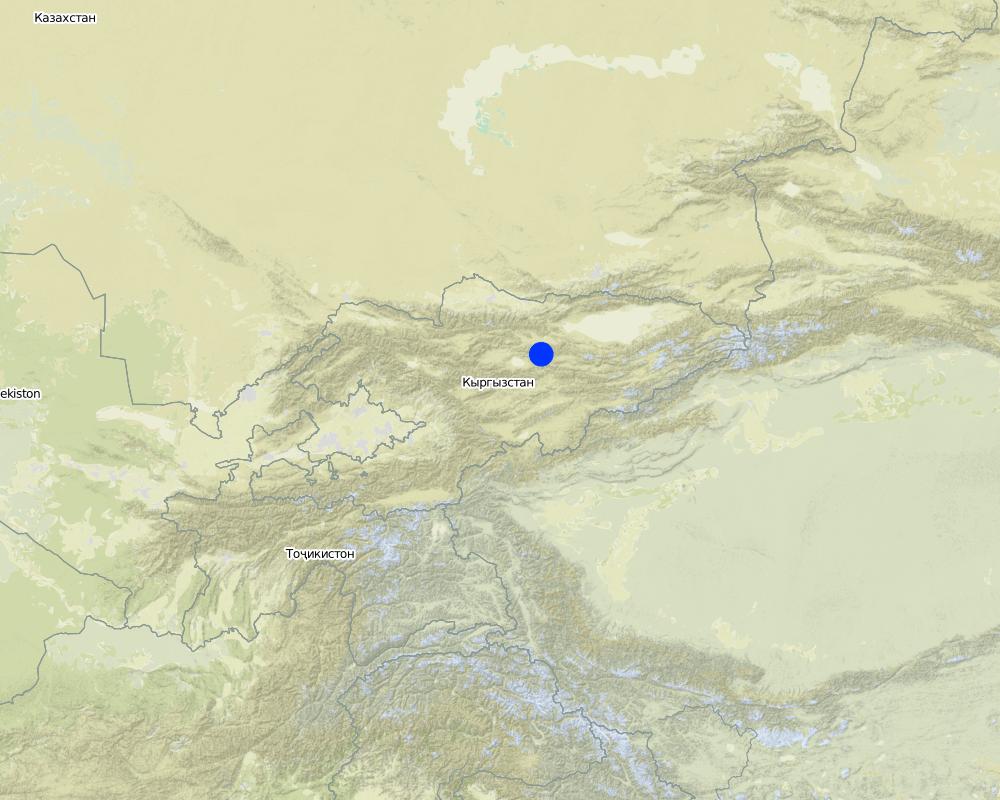Joint Wildlife Management in the mountain ecosystem of the Naryn region in Kyrgyzstan [คีร์กีซสถาน]
- ผู้สร้างสรรค์:
- การอัพเดท:
- ผู้รวบรวม: Nazgul Esengulova
- ผู้เรียบเรียง: –
- ผู้ตรวจสอบ: Alexandra Gavilano, David Streiff
Нарын областында тоолуу экосистемаларынын табигый анчылык ресурстарын жергиликтуу жамааттардын негизинде колдонуу
approaches_2582 - คีร์กีซสถาน
ดูส่วนย่อย
ขยายทั้งหมด ย่อทั้งหมด1. ข้อมูลทั่วไป
1.2 รายละเอียดที่ติดต่อได้ของผู้รวบรวมและองค์กรที่เกี่ยวข้องในการประเมินและการจัดเตรียมทำเอกสารของแนวทาง
ผู้เชี่ยวชาญ SLM:
ชื่อของโครงการซึ่งอำนวยความสะดวกในการทำเอกสารหรือการประเมินแนวทาง (ถ้าเกี่ยวข้อง)
Deutsche Gesellschaft für Internationale Zusammenarbeit (GIZ) GmbH (GIZ) - เยอรมนี1.3 เงื่อนไขที่เกี่ยวข้องกับการใช้ข้อมูลที่ได้บันทึกไว้ผ่านทาง WOCAT
วันที่เก็บรวบรวมข้อมูล (ภาคสนาม):
11/05/2012
ผู้รวบรวมและวิทยากรหลักยอมรับเงื่อนไขเกี่ยวกับการใช้ข้อมูลที่ถูกบันทึกผ่านทาง WOCAT:
ใช่
2. คำอธิบายของแนวทาง SLM
2.1 การอธิบายแบบสั้น ๆ ของแนวทาง
Joint Wildlife Management based on economic empowerment and assigning hunting (wildlife) grounds to the Association of local hunters and providing her with user rights for game resources leads to a sustainable use of natural resources and biodiversity and wildlife conservation (in the frame of CACILM).
2.2 การอธิบายอย่างละเอียดของแนวทาง
การอธิบายอย่างละเอียดของแนวทาง:
Aims / objectives: Wildlife in Kyrgyzstan, especially mountain ungulates, is threatened because these resources can be easily accessed due to an inadequate state supervision and regulation as well as due to lack of knowledge among the local population and mechanism for integrated land use (considering different coordinated types of resource use) and resource conservation. Decrease in the natural habitat (caused by the expansion of pasture and arable land) and illegal hunting lead to a decrease in wildlife populations. In Kyrgyzstan, the fauna is exclusively owned by the state. User rights for wildlife are separated from land use ones. The approach aims at the conservation and sustainable use of wildlife based on providing representatives of the local community, organized in an Association of local hunters (ALH), with legal user rights for wildlife resources.
Methods: (1) supporting local hunters in organizing an Association of local hunters (ALH) with the help of facilitators; (2) transferring wildlife management functions from the Wildlife Department to the ALH based on assigning hunting grounds to them and providing them with user rights according to jointly developed management plans; (3) building trust in partnership relations between the ALH and the Wildlife Department of State Agency for Environmental Protection and Forestry (SAEPF) based on joint registration and monitoring and determination of the resource status (see Annex 3); (4) capacity building of the ALH with the help of independent experts and advising activities provided by the Wildlife Department; (5) developing an atmosphere of trust by establishing links between the Wildlife Department, local hunters (ALH), the local community (Aiylokmotu) and rural organizations (Pasture User Association, PUA) based on joint planning and information sharing.
Stages of implementation: (1) setting up groups of well-trained (sensitive) facilitators and training them on the principles of facilitation, conflict management and sustainable management of natural resources; (2) identifying reliable active hunters with the help of facilitators and managers by interviewing neutral people; (3) organizing a meeting at the field level to analyze the situation and identify interests in establishing of the ALH; (4) raising awareness of local hunters on wildlife resources, existing problems and possible solutions offered by sustainable management; (5) establishing an ALH in the pilot area as a legal entity; (6) assigning areas to the ALH and advising activities on methods for wildlife management provided by the Wildlife Department and the specialized NGO 'Ak-Terek'; (7) organizing expeditions with specialists from the Wildlife Department to register and monitor the resource status; (8) developing a management plan with the support of experts from the Wildlife Department and independent experts, plan approval and implementation.
2.3 รูปภาพของแนวทาง
2.5 ประเทศ ภูมิภาค หรือสถานที่ตั้งที่ได้นำแนวทางไปใช้
ประเทศ:
คีร์กีซสถาน
ภูมิภาค/รัฐ/จังหวัด: :
Kyrgyzstan, Naryn oblast
ข้อมูลเฉพาะเพิ่มเติมของสถานที่ตั้ง:
Kochkor district, Toloksky Aiylokmotu (villages Tolok and Kok-Jar)
ความคิดเห็น:
Tolok village is situated at 2343 meters above sea level. Hunting grounds are located in the basin of Tolok river in a narrow gorge in the area of alpine meadows with a middle degree of soil degradation. The area is inhabited by wild mountain goats, deer, wolves, foxes, marmots, hares, partridges.
Map
×2.6 วันที่เริ่มต้นและสิ้นสุดของแนวทาง
ระบุปีที่เริ่ม:
2010
การสิ้นสุดลง (ถ้าแนวทางไม่ได้ใช้อีกต่อไป):
2014
2.7 ประเภทของแนวทาง
- ใช้โครงงานหรือแผนงานเป็นฐาน
2.8 เป้าหมายหรือวัตถุประสงค์หลักของแนวทาง
The Approach focused mainly on other activities than SLM (Transferring responsibilities of wildlife management to the local population, assigning hunting grounds to the Association of local Hunters and providing her with legal user rights for game resources, sustainable management of wildlife and joint planning)
The approach aims at conservation and sustainable use of wildlife based on economic empowerment and transfer of legal use rights for wildlife resources to representatives of the local community, organized in the Association of local hunters according to jointly developed management plans.
The SLM Approach addressed the following problems: Decrease in wildlife populations due to an unregulated unsustainable use of resources by the local population and due to lack of participatory mechanisms for the population to manage these resources, inadequate state regulation and supervision, aggravated by a conflict of interest among users over other natural resources with different intentions (pasture, forest, mineral resources, tourism).
2.9 เงื่อนไขที่เอื้ออำนวยหรือเป็นอุปสรรคต่อการนำเทคโนโลยีภายใต้แนวทางนี้ไปปฏิบัติใช้
บรรทัดฐานและค่านิยมทางสังคม วัฒนธรรม ศาสนา
- เป็นอุปสรรค
Hunting is basically illegal. Local hunters do not trust the new approach of wildlife management and have no capacity for self-organization and no experience of joint decision making.
Treatment through the SLM Approach: Providing necessary information to the local population by holding meetings and seminars with representatives of the Wildlife Department. Trainings on capacity building for self-organization.
การมีไว้ให้หรือการเข้าถึงแหล่งการเงินและบริการ
- เป็นอุปสรรค
There is a need for initial investment to get the ALH started and deferred revenues are expected. The ALH is not expected to extract big financial revenues from wildlife management and wildlife use.
Treatment through the SLM Approach: Explanation of financial expectations (exclusive right of first access to game resources and authority of access right distribution, patriotism)
การจัดตั้งระดับองค์กร
- เป็นอุปสรรค
There is a lack of joint organizations at the field level which manage wildlife resources sustainably.
Treatment through the SLM Approach: Establishing an Association of local hunters to manage wildlife resources sustainably
กรอบแนวทางในการดำเนินการด้านกฎหมาย (การถือครองที่ดิน สิทธิในการใช้ที่ดินและน้ำ)
- เอื้ออำนวย
- เป็นอุปสรรค
There is a lack of policy promoting Joint Wildlife Management
Treatment through the SLM Approach: Order of the Wildlife Department, Concept of Reform for wildlife sector prohibiting state agencies to manage wildlife economically, promoting the assignment of wildlife areas to the ALH
The existing land ownership, land use rights / water rights greatly hindered the approach implementation Existing legislation does not comply with the principles of sustainable use and wildlife management and does not promote Joint Wildlife Management. There is a lack of regulation and integration of land users.
ความรู้เกี่ยวกับ SLM การเข้าถึงการสนับสนุนด้านเทคนิค
- เป็นอุปสรรค
The local population has no necessary capacities (environmental awareness, knowledge of sustainable wildlife management).
Treatment through the SLM Approach: Trainings
3. การมีส่วนร่วมและบทบาทของผู้มีส่วนได้ส่วนเสียที่เกี่ยวข้อง
3.1 ผู้มีส่วนได้ส่วนเสียที่เกี่ยวข้องในแนวทางนี้และบทบาท
- ผู้ใช้ที่ดินระดับท้องถิ่นหรือชุมชนระดับท้องถิ่น
Hunters from the villages Kok-Djar and Tolel in the Naryn region
Hunting is a traditionally male-dominated activity
Pasture user committees
- องค์กรที่ขึ้นอยู่กับชุมชน
- องค์กรพัฒนาเอกชน
Public Foundation “Ak-Terek”
- รัฐบาลแห่งชาติ (ผู้วางแผน ผู้ทำการตัดสินใจ)
Wildlife Department of SAEPF
- องค์การระหว่างประเทศ
GIZ Regional Program on Sustainable Use of Natural Resources via the Project “Sustainable use of the mountain ungulate species in Kyrgyzstan”
3.2 การเกี่ยวข้องของผู้ใช้ที่ดินระดับท้องถิ่นหรือชุมชนระดับท้องถิ่นในช่วงต่างๆของแนวทาง
| ความเกี่ยวข้องของผู้ใช้ที่ดินระดับท้องถิ่นหรือชุมชนระดับท้องถิ่น | ระบุผู้ที่มีส่วนเกี่ยวข้องและอธิบายกิจกรรม | |
|---|---|---|
| การริเริ่มหรือการจูงใจ | ปฏิสัมพันธ์ | Consulting with the Wildlife Department |
| การวางแผน | ปฏิสัมพันธ์ | Participation at discussing the approach design and determining the form and specifics of self-organization |
| การดำเนินการ | ปฏิสัมพันธ์ | Local hunters implement the approach through their representatives in the ALH |
| การติดตามตรวจสอบหรือการประเมินผล | ปฏิสัมพันธ์ | Monitoring and evaluation are conducted on base of questionnaires and interviews with key actors supported by the Wildlife Department and GIZ Project and on base of annual progress assessment in reports prepared for the Wildlife Department (increase in wildlife population, reducing conflicts among resource users). |
| Research | ไม่มี |
3.3 แผนผังแสดงขั้นตอนการทำงาน (ถ้ามี)
คำอธิบาย:
The approach has been implemented by the GIZ project 'Sustainable management of the mountain ungulate species' under the Regional Program on Sustainable Use of Natural Resources in Central Asia which initiated and implemented establishment of the ALH in conjunction with the Wildlife Department and the NGO 'Ak-Terek'. The Wildlife Department has developed new methods for monitoring and determining wildlife quotas. The NGO 'Ak-Terek' promotes and facilitates self-organization of hunters in the ALH, mitigate possible conflicts arising in the integrated land use. Local hunters are organized into the ALH, defining her structure and principles of organization (legal status, functions, membership), as well as monitoring and developing management plan, etc. The Wildlife Department confirms the legal assignment of wildlife areas to the ALH and provides advice to them on game management.
ผู้เขียน:
Nazgul Esengulova (720001, Logvinenko St., 26а, Bishkek, Kyrgyzstan )
3.4 การตัดสินใจเลือกใช้เทคโนโลยี SLM
ระบุผู้ที่ทำการตัดสินใจเลือกเทคโนโลยีมากกว่าหนึ่งวิธีไปปฏิบัติใช้:
- Experts from the Wildlife Department
การอธิบาย:
In a seminar involving the local population and project experts and experts from the NGO 'Ak-Terek' as facilitators in order to explain the principles of wildlife management.
Decisions on the method of implementing the SLM Technology were made by mainly by land users supported by SLM specialists. Decisions were made by the village population supported by WLD experts.
In the meeting of key hunters, shepherds and other interested residents of the village with the project staff and the Foundation 'Ak-Terek', there was determined a form of local self-organization of wildlife users.
4. การสนับสนุนด้านเทคนิค การสร้างขีดความสามารถ และการจัดการด้านความรู้
4.1 การสร้างขีดความสามารถ / การอบรม
ได้มีการจัดอบรมให้แก่ผู้ใช้ที่ดินหรือผู้มีส่วนได้ส่วนเสียคนอื่น ๆ หรือไม่:
ใช่
ให้ระบุว่าใครเป็นผู้ได้รับการอบรม:
- ผู้ใช้ที่ดิน
- Wildlife Department
ถ้าเกี่ยวข้อง ให้ระบุ เพศ อายุ สถานภาพ ชาติพันธุ์ เป็นต้น:
Mainly males at age 40-50
รูปแบบการอบรม:
- กำลังดำเนินการ
- เกษตรกรกับเกษตรกร
- จัดการประชุมสู่สาธารณชน
รูปแบบการอบรม:
- 2 day seminars on the spot
หัวข้อที่พูด:
1. Raising awareness of actual problems and possible solutions; joint mapping of resources and discussion of scenarios for development of hunting grounds;
2. Principles of sustainable wildlife use;
3. Methods for monitoring and registering the number of wild animals;
4. Planning economic activities of game management for an assigned area;
5. Professional ethics of game users;
6. Programs for employees of environmental, law enforcement and customs authorities.
4.2 การบริการให้คำแนะนำ
ผู้ใช้ที่ดินมีการเข้าถึงการรับบริการให้คำปรึกษาหรือไม่:
ใช่
ระบุว่ามีบริการให้คำปรึกษาหรือไม่:
- ไปเยี่ยมชมสถานที่
การอธิบาย/แสดงความคิดเห็น:
Name of method used for advisory service: situation analysis; Key elements: on-site visit, group consultation during workshop, preparation of resource map
Advisory service is quite adequate to ensure the continuation of land conservation activities; Department with its local staff and the NGO 'Ak-Terek' are capable to continue providing advisory services after the project finishes.
4.3 การเสริมความแข็งแกร่งให้กับสถาบัน (การพัฒนาองค์กร)
สถาบันได้รับการจัดตั้งขึ้นมาหรือเสริมความแข็งแกร่งโดยแนวทางนี้หรือไม่:
- ไม่
4.4 การติดตามตรวจสอบและประเมินผล
การติดตามตรวจสอบและประเมินผลเป็นส่วนหนึ่งของแนวทางหรือไม่:
ใช่
ความคิดเห็น:
Bio-physical aspects were regular monitored by project staff, land users through observations; indicators: expeditions, field researches, surveys
Bio-physical aspects were regular monitored by project staff, land users through measurements; indicators: number of wild animals
Economic / production aspects were regular monitored by project staff through measurements; indicators: benefit from selling hunting tours and ecotourism
No. of land users involved aspects were regular monitored by project staff through measurements; indicators: Number of hunters and associations
Management of Approach aspects were regular monitored by project staff, government through observations; indicators: annual planning, monitoring of achievement and difficulties, adaptation of the approach if necessary
There were no changes in the Approach as a result of monitoring and evaluation
There were no changes in the Technology as a result of monitoring and evaluation
4.5 การวิจัย
การวิจัยเป็นส่วนหนึ่งของแนวทางหรือไม่:
ไม่ใช่
5. การสนับสนุนด้านการเงินและวัสดุอุปกรณ์
5.1 ระบุงบประมาณประจำปีสำหรับแนวทาง SLM นี้
ถ้าหากว่างบประมาณประจำปีไม่เป็นที่ทราบแน่นอน ให้ระบุช่วงลงไป:
- 10,000-100,000
แสดงความคิดเห็น (แหล่งของการระดมทุน ผู้บริจาคคนสำคัญ):
Approach costs were met by the following donors: international (GIZ, via “Sustainable use of the mountain ungulate species in Kyrgyzstan” ): 95.0%; government (Wildlife Department of SAEPF): 5.0%; national non-government (PF “Ak-Terek” ); local community / land user(s) (local resource users )
5.2 การสนับสนุนด้านการเงิน / วัสดุอุปกรณ์ให้แก่ผู้ใช้ที่ดิน
ผู้ใช้ที่ดินได้รับการสนับสนุนด้านการเงิน / วัสดุอุปกรณ์ไปปฏิบัติใช้เทคโนโลยีหรือไม่:
ไม่ใช่
5.3 เงินสนับสนุนสำหรับปัจจัยนำเข้า (รวมถึงแรงงาน)
- อุปกรณ์
| ระบุปัจจัยนำเข้าที่ได้รับการสนับสนุน | เห็นด้วยระดับไหน | ระบุเงินสนับสนุน |
|---|---|---|
| Tools, binoculars, GPS navigators, tents | ได้รับการช่วยเหลือทางการเงินบางส่วน | |
ถ้าแรงงานโดยผู้ใช้ที่ดินเป็นปัจจัยนำเข้าที่มีอยู่มากมาย ระบุด้วยว่าเนื่องจาก:
- สมัครใจ
ความคิดเห็น:
Voluntary participation in monitoring and registering as well as analyzing wildlife areas for the further assignment of hunting grounds to hunters
5.4 เครดิต
มีการจัดหาเครดิตมาให้ภายใต้แนวทาง SLM หรือไม่:
ไม่ใช่
6. การวิเคราะห์ผลกระทบและการสรุป
6.1 ผลกระทบของแนวทาง
ช่วยให้ผู้ใช้ที่ดินนำเอาเทคโนโลยี SLMไปใช้และบำรุงรักษาสภาพไว้ได้หรือไม่:
- ไม่ใช่
- ใช่ เล็กน้อย
- ใช่ ปานกลาง
- ใช่ อย่างมาก
With establishing the Association of local hunters and involving the latter into wildlife management, stabilization and even an increasing tendency of wildlife populations according to ecosystem's carrying capacity have been made possible. Joint planning and activities in the assigned areas decreased the number of conflicts over resources. Diversification of land use and a better integration of land users are present.
ทำให้กลุ่มด้อยโอกาสมีอำนาจทางสังคมและเศรษฐกิจหรือไม่:
- ไม่ใช่
- ใช่ เล็กน้อย
- ใช่ ปานกลาง
- ใช่ อย่างมาก
ปรับปรุงประเด็นของการถือครองที่ดินหรือสิทธิในการใช้ ซึ่งขัดขวางการนำเทคโนโลยีไปใช้ให้ดีขึ้น:
- ไม่ใช่
- ใช่ เล็กน้อย
- ใช่ ปานกลาง
- ใช่ อย่างมาก
Integrating approaches of wildlife management (a relevant order of the Hunting Department) before a new law 'On Hunting' is adopted. Economic empowerment of the LAH and political will for the issue. Increase in sensibility of the main resource users concerning the conservation of biodiversity.
Did other land users / projects adopt the Approach?
- ไม่ใช่
- ใช่ เล็กน้อย
- ใช่ ปานกลาง
- ใช่ อย่างมาก
The project is extended over other areas in Kyrgyzstan (Kemin, Ak-Suu and Talas regions) and in Khatlon and Gorno-Badakhshan oblasts of Tajikistan (Shurabad, Darvaz, Rushan, Ishkakshim, Murghab regions).
Did the Approach lead to improved livelihoods / human well-being?
- ไม่ใช่
- ใช่ เล็กน้อย
- ใช่ ปานกลาง
- ใช่ อย่างมาก
Legally ongoing recreational hunting. Revenue increase resulting from the wildlife protection due to legalization of hunting and sustainable resource management.
Did the Approach help to alleviate poverty?
- ไม่ใช่
- ใช่ เล็กน้อย
- ใช่ ปานกลาง
- ใช่ อย่างมาก
Since the target group does not refer to very poor people
6.2 แรงจูงใจหลักของผู้ใช้ที่ดินเพื่อที่จะนำ SLM ไปปฏิบัติใช้
- กำไร (ความสามารถ) อัตราส่วนค่าใช้จ่ายต่อผลประโยชน์ที่เพิ่มขึ้น
Additional income from hunting tours
- กฎและระเบียบ (ค่าปรับ) หรือการบังคับใช้
Legalization of hunting
- เกียรติภูมิ แรงกดดันทางสังคม ความเชื่อมแน่นทางสังคม
Attitude of local people to illegal hunting
- จิตสำนึกด้านสิ่งแวดล้อม
Moral improvement of society
- well-being and livelihoods improvement
Additional income from hunting tours
- Improvement of ecosystem
Wildlife protection improves the ecosystem where local people live
6.3 ความยั่งยืนของกิจกรรมของแนวทาง
ผู้ใช้ที่ดินสามารถทำให้สิ่งต่างๆ ที่ได้ปฏิบัติใช้โดยแนวทางนี้ยั่งยืนได้หรือไม่ (โดยไม่มีการสนับสนุนจากภายนอก):
- ใช่
ถ้าตอบว่าใช่ ให้อธิบายว่าอย่างไร :
5 years later, after the number of wild animals in the assigned area is increased. During this period, members of the Association would realize the obvious long-term benefits resulting from the new approach (increasing wildlife population would lead to an increase in hunting licenses issued) and would become experienced in sustainable game management.
6.4 จุดแข็งและข้อได้เปรียบของแนวทาง
| จุดแข็ง / ข้อได้เปรียบของแนวทางในทัศนคติของผู้ใช้ที่ดิน |
|---|
| Opportunity to lobby for own interests through Hunters’ Association in the local community (Aiylokmotu). |
| Opportunity to extract revenue from hunting tours. |
| Opportunity to legalize hunting. |
| Opportunity to manage resources in the assigned area and to plan how to use them. (How to sustain/ enhance this strength: Trainings and expert advice from the Wildlife Department and the Academy of Sciences of KR.) |
| จุดแข็ง / ข้อได้เปรียบของแนวทางในทัศนคติของผู้รวบรวมหรือวิทยากรหลัก |
|---|
| Users of various natural resources (pasture, beekeepers, hunters) jointly plan their activities and use resources. (How to sustain/ enhance this strength: Increasing awareness of the local population on degradation of natural resources and the need for their careful use.) |
| Resource use and management are transferred in the hands of resource users. (How to sustain/ enhance this strength: Adoption of necessary legislation to establish wildlife user associations.) |
| Positive impact on the local ecosystem: stabilization of the wildlife population resulting from of protection of the assigned area and limited shooting. (How to sustain/ enhance this strength: Trainings for hunters on a new method of registration and monitoring of wild animals in order to determine the status of wildlife populations.) |
| Active and regular participation and support of the Wildlife Department in planning and implementing approach and creating an atmosphere of trust. |
6.5 จุดอ่อน / ข้อเสียเปรียบของแนวทางและวิธีในการแก้ไข
| จุดอ่อน / ข้อเสียเปรียบในทัศนคติของผู้ใช้ที่ดิน | สามารถแก้ไขปัญหาได้อย่างไร |
|---|---|
| Deferred minor revenue over the first years of implementation related to an increase in wildlife populations. | Development of ecotourism as a primary source of income. In the future, ecotourism can be practiced along with hunting tourism, providing additional income. |
| จุดอ่อน / ข้อเสียเปรียบในทัศนคติของผู้รวบรวมหรือวิทยากรหลัก | สามารถแก้ไขปัญหาได้อย่างไร |
|---|---|
| Resource users have poor capacities for self-organization and are incapable of coherent collective actions. | Consultancy, meetings, involvement of conflict managers and facilitators. |
7. การอ้างอิงและการเชื่อมต่อ
7.1 วิธีการหรือแหล่งข้อมูล
- ไปเยี่ยมชมภาคสนาม การสำรวจพื้นที่ภาคสนาม
- การสัมภาษณ์กับผู้ใช้ที่ดิน
7.2 การอ้างอิงถึงสิ่งตีพิมพ์
ชื่อเรื่อง ผู้เขียน ปี ISBN:
Final Report for GIZ 'Analysis and Preliminary Results of the Joint Wildlife Management Component of the Project
ช่องทางในการสืบค้น และราคา:
Pesch Markus
ลิงก์และโมดูล
ขยายทั้งหมด ย่อทั้งหมดลิงก์
ไม่มีลิงก์
โมดูล
ไม่มีโมดูล


